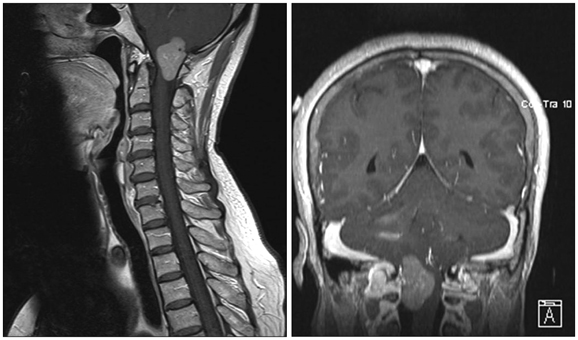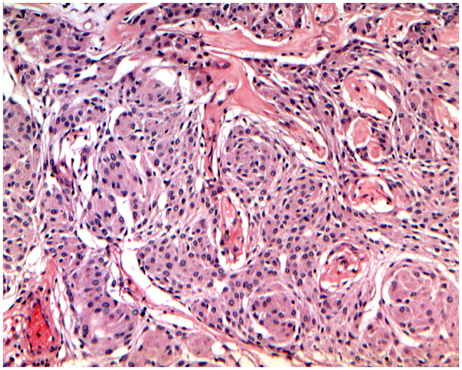J Clin Neurol.
2009 Dec;5(4):198-200. 10.3988/jcn.2009.5.4.198.
Occipital Neuralgia as the Only Presenting Symptom of Foramen Magnum Meningioma
- Affiliations
-
- 1Department of Neurology, Dongguk University College of Medicine, Goyang, Korea. nheekim8@paran.com
- 2Department of Neurosurgery, Dongguk University College of Medicine, Goyang, Korea.
- 3Department of Radiology, Dongguk University College of Medicine, Goyang, Korea.
- KMID: 2287651
- DOI: http://doi.org/10.3988/jcn.2009.5.4.198
Abstract
- BACKGROUND
Occipital neuralgia (ON) is a condition characterized by a paroxysmal stabbing pain in the area of the greater or lesser occipital nerves; it is usually regarded by clinicians as idiopathic. Some have suggested that ON can be induced by trauma or injury of the occipital nerves or their roots, but tumor has rarely been reported as a cause of ON. CASE REPORT: We report herein a case of foramen magnum meningioma in a 55-year-old woman who presented with ON triggered by head motion as the only symptom without any signs of myelopathy. CONCLUSIONS: This case indicates that it is important to consider the underlying causes of ON. Precise neurologic and radiological evaluations such as cervical spine magnetic resonance imaging are needed.
Keyword
MeSH Terms
Figure
Reference
-
1. Headache Classification Subcommittee of the International Headache Society. The International Classification of Headache Disorders: 2nd edition. Cephalalgia. 2004. 24:Suppl 1. 9–160.2. Hammond SR, Danta G. Occipital neuralgia. Clin Exp Neurol. 1978. 15:258–270.3. Boes CJ. C2 myelitis presenting with neuralgiform occipital pain. Neurology. 2005. 64:1093–1094.
Article4. Arasil E, Erdem A, Yüceer N. Osteochondroma of the upper cervical spine. A case report. Spine (Phila Pa 1976). 1996. 21:516–518.5. Garza I. Craniocervical junction schwannoma mimicking occipital neuralgia. Headache. 2007. 47:1204–1205.
Article6. Clavel M, Clavel P. Occipital neuralgia secondary to exuberant callus formation. Case report. J Neurosurg. 1996. 85:1170–1171.7. Levy WJ Jr, Bay J, Dohn D. Spinal cord meningioma. J Neurosurg. 1982. 57:804–812.
Article
- Full Text Links
- Actions
-
Cited
- CITED
-
- Close
- Share
- Similar articles
-
- Ventral Foramen Magnum Meningioma: Case Report
- Foramen Magnum Tumors
- Coincidental Nasopharyngeal Carcinoma and Ventral Foramen Magnum Meningioma: Case Report and Review of the Literature
- The Operative Treatment for the Meningiomas in the low Clivus and Foramen Magnum
- Lateral Approach to Ventral Meningioma of the Upper Cervical Spinal Canal



